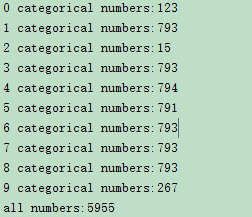When I classify digital images for identification (sample distribution is not balanced),why is the validation set highly accurate , and the test set is only 2%, and the weighted loss is about 30% (accuracy is low)?
Is there any other way to improve the accuracy of the test set?
The distribution of my training set is:

all code is here:
# -*- coding: utf-8 -*-
"""
Created on Fri May 10 09:03:47 2019
测试加权损失函数的有效性,matlab代码的复现版
# https://ww2.mathworks.cn/matlabcentral/answers/461076-why-is-the-validation-set-highly-accurate-99-and-the-test-set-is-only-21-and-the-weighted-loss
@author: cuixingxing
"""
import torch
import torch.nn as nn
from torch.utils.data import DataLoader
import torchvision
import torchvision.transforms as transforms
import torch.nn.functional as F
import time
import os
import numpy as np
input_size = (1,28,28)
#%% 网络结构
class testNet(nn.Module):
def __init__(self,input_size=input_size):
super(testNet, self).__init__()
self.conv1 = torch.nn.Sequential(
torch.nn.Conv2d(1, 32, 3, 1, 1),
torch.nn.BatchNorm2d(32),
torch.nn.ReLU(),
torch.nn.MaxPool2d(2))
self.conv2 = torch.nn.Sequential(
torch.nn.Conv2d(32, 64, 3, 1, 1),
torch.nn.ReLU(),
torch.nn.MaxPool2d(2))
self.conv3 = torch.nn.Sequential(
torch.nn.Conv2d(64, 64, 3, 1, 1),
torch.nn.ReLU(),
torch.nn.MaxPool2d(2))
n_size = self._get_linear_inNums(input_size)#根据输入图像大小自动推断fc层输入
print('linear input number:{:}'.format(n_size))
self.dense = torch.nn.Sequential(
torch.nn.Linear(n_size , 10)
)
def _get_linear_inNums(self,shape):
batch_x = 1
temp = torch.rand(batch_x,*shape)
single_feature = self._forward_features(temp)
n_size = single_feature.view(batch_x,-1).size(1)
return n_size
def _forward_features(self,x):
x = self.conv1(x)
# x = self.conv2(x)
# x = self.conv3(x)
return x
def forward(self, x):
out = self._forward_features(x)
# print('out.size():',out.size())
res = out.view(out.size(0),-1)
out = self.dense(res)
out = F.softmax(out,dim = 1)
return out
def trainNetWork(train_loader,val_loader,lossFcn,log_file):
net = testNet()
net.cuda() #把网络推送到GPU
net.train()
#print(net)
optimizer = torch.optim.SGD(net.parameters(),lr= 0.05)
#torch.cuda.set_device(0)
#loss_func.cuda() # 损失函数推送到GPU
times = 0
train_loss = 0.
train_corr_all =0
numSamples = 0
valFrequencePerIters = 30 # 每30次迭代就验证一次准确度,防止过拟合
fid = open(log_file,"w")
for epoch in range(10):
print('epoch {}'.format(epoch + 1))
# training-----------------------------
for batch_x, batch_y in train_loader:
times+=1
batch_x = batch_x.cuda() # 推送到GPU
batch_y = batch_y.cuda() # 推送到GPU
out = net(batch_x)
loss = lossFcn(out, batch_y)
train_loss += loss.item()
pred = torch.max(out, 1)[1]
train_correct = (pred == batch_y).sum()
train_corr_all += train_correct.item()
optimizer.zero_grad()
loss.backward()
optimizer.step()
if times%valFrequencePerIters==0: # val
numsCorrect = 0
for val_x,val_y in val_loader:
val_x = val_x.cuda()
val_y = val_y.cuda()
val_out = net(val_x)
pred_val = torch.max(val_out,dim=1)[1]
numC = (pred_val==val_y).sum()
numsCorrect += numC.item()
strings_val = "val acc:{}".format(numsCorrect/len(val_db))
print(strings_val)
fid.write(strings_val+'\n')
numSamples+=len(batch_x)
strings = "iter:{:d},train average acc:{:.6f},average loss:{:.6f}".format(times,train_corr_all/(numSamples),
train_loss / numSamples)
print(strings)
fid.write(strings+'\n')
# 保存模型 checkpoint
if times % 100 == 0:
print('saving ....')
timestr = time.strftime('%Y-%m-%d_%H-%M-%S',time.localtime(time.time()))
save_file_path = os.path.join('./save/', '{0}_{1}_{2}.pth'.format(times,timestr,epoch))
states = {
'epoch': epoch + 1,
'state_dict': net.state_dict(),
'optimizer' : optimizer.state_dict(),
}
torch.save(states, save_file_path)
fid.close()
return net
def test_accuracy(net,test_loader):
"""
测试集准确度
"""
net.eval()
numsTestCorr = 0
for batch_testX,batch_testY in test_loader:
batch_testX = batch_testX.cuda()
batch_testY = batch_testY.cuda()
out = net(batch_testX)
pred = torch.max(out,dim=1)[1]
numsC= (pred==batch_testY).sum()
numsTestCorr+=numsC.item()
return numsTestCorr/len(test_sets)
# %% main
if __name__ == '__main__':
train_sets = torchvision.datasets.ImageFolder(r'D:\test_video\digitRec\train',
transform = transforms.Compose([
transforms.Grayscale(input_size[0]),
transforms.Resize(input_size[1:]),
transforms.ToTensor()]))
test_sets = torchvision.datasets.ImageFolder(r'D:\test_video\digitRec\test',
transform = transforms.Compose([
transforms.Grayscale(input_size[0]),
transforms.Resize(input_size[1:]),
transforms.ToTensor()]))
trainNums = int(torch.floor(0.8*torch.Tensor([len(train_sets)])).item()) # 80%的数据用于训练,剩下20%用于验证
train_db, val_db = torch.utils.data.random_split(train_sets, [trainNums, len(train_sets)-trainNums])
loss_func = torch.nn.CrossEntropyLoss() # no add weighted CrossEntropyLoss
train_indexs = train_db.indices
labels = [ str(train_sets.samples[i][1]) for i in train_indexs]
weights = [1./labels.count(name) for name in train_sets.classes]
weights = torch.FloatTensor(weights).cuda()
loss_func_weight = torch.nn.CrossEntropyLoss(weight = weights) # add weighted CrossEntropyLoss
train_loader = DataLoader(train_db,batch_size = 25,shuffle = True) # ,drop_last = True
val_loader = DataLoader(val_db,batch_size = 25,shuffle = True) # ,drop_last = True
test_loader = DataLoader(test_sets,batch_size = 25,shuffle = True) # ,drop_last = True
# %% train
net = trainNetWork(train_loader,val_loader,loss_func,"trainInfor.txt")
net_weighted = trainNetWork(train_loader,val_loader,loss_func_weight,"trainInfor_weighted.txt")
# %% test accuracy
acc = test_accuracy(net,test_loader)
strings_test = "no add weighted, all test data acc:{}".format(acc)
print(strings_test) # low acc ?
# %% after weighted ,test accuracy
acc = test_accuracy(net_weighted,test_loader)
strings_test = "after add weighted ,all test data acc:{}".format(acc) # also low acc?
print(strings_test)
The data and recurring version of the matlab version is here.